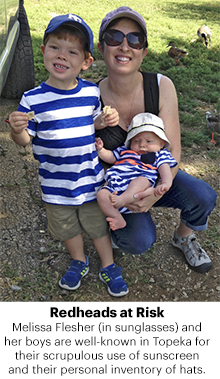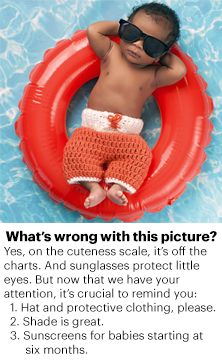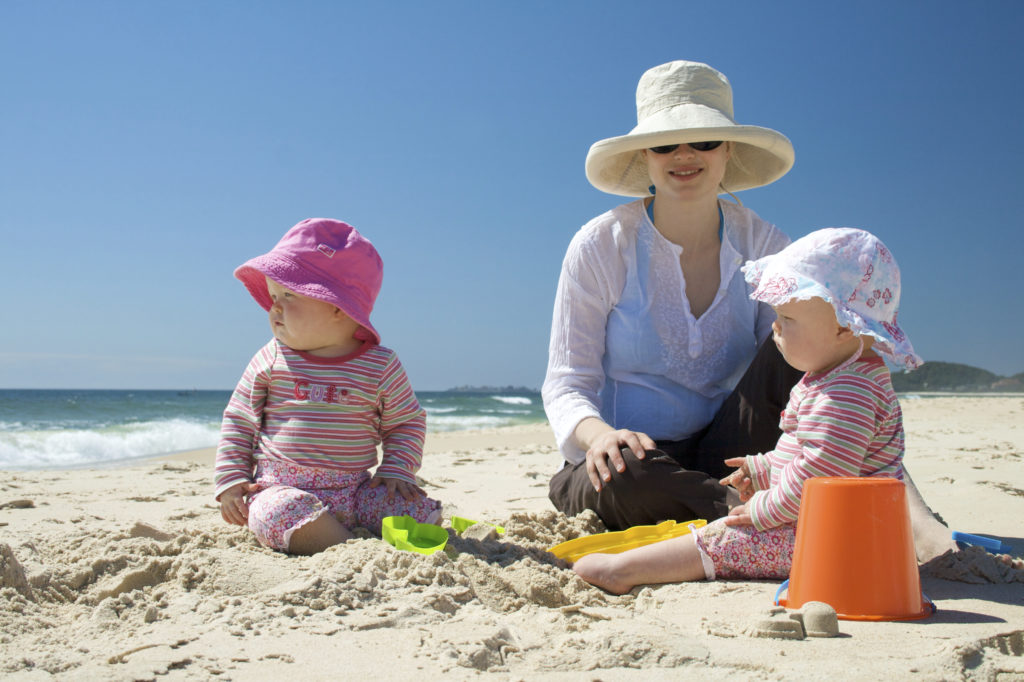Photo: iStock
Parents’ instinct is to protect their infants and toddlers from harm. Yet our experts report that too many babies are getting tans and sunburns. Here, we offer their simple tips to prevent damage to your child’s skin that could lead to skin cancer.
By FLETA N. BRAY, MD, KEYVAN NOURI, MD, and COLLEAGUES
Melissa Flesher, a mother of two young boys in Topeka, Kansas, knows firsthand how dangerous the sun can be. She remembers being sunburned as a child from daily summertime trips to the pool with friends. She also used tanning beds in high school and college. In 2010, when she was 36 years old and seven months pregnant, she was diagnosed with a stage I melanoma on the back of her thigh. Luckily her doctor caught it early, but it was a scary wakeup call. Now that Melissa and her husband, Ryan, have two boys who inherited the same light skin tone she and Ryan have, she worries about keeping them protected.
Infants at Risk
 She’s right to be concerned. Research shows that some babies are being exposed to the sun’s damaging ultraviolet (UV) rays in the first six months of life, when their skin is most vulnerable. When our research team at the University of Miami surveyed local parents about how well they were protecting their young children from the sun, the results were alarming. Many parents’ efforts were inconsistent. Worse, we found that as many as one-third of parents actively increased their infants’ sun exposure each day, believing mistakenly that it would build their babies’ tolerance to the sun’s rays. As a result, 12 percent of the parents reported that their babies’ skin had tanned before they were 6 months old, and 3 percent said their infants had been sunburned.
She’s right to be concerned. Research shows that some babies are being exposed to the sun’s damaging ultraviolet (UV) rays in the first six months of life, when their skin is most vulnerable. When our research team at the University of Miami surveyed local parents about how well they were protecting their young children from the sun, the results were alarming. Many parents’ efforts were inconsistent. Worse, we found that as many as one-third of parents actively increased their infants’ sun exposure each day, believing mistakenly that it would build their babies’ tolerance to the sun’s rays. As a result, 12 percent of the parents reported that their babies’ skin had tanned before they were 6 months old, and 3 percent said their infants had been sunburned.
There is strong evidence that sun exposure and sunburns during childhood multiply the risk of one day developing skin cancer, including melanoma. While melanoma still rarely develops before age 20, incidence in children and teens is rising rapidly. The skin of all infants (not just those who have lighter skin) is particularly vulnerable to sun damage. This is partly because they haven’t yet developed all the melanin — the natural skin pigment that provides some sun protection — that they will have when they get older.
How to Protect Your Baby
Because infants’ skin is so sensitive, it’s better in the first six months to shield them from the sun rather than use sunscreen. It’s especially important to avoid direct sun exposure and seek the shade during the sun’s hours of greatest intensity, between 10 AM and 4 PM. Keep to the shady side of the street on walks, and use the sun shield on your stroller.
It’s also best to dress your baby regularly in a brimmed hat and lightweight clothing that fully covers the arms and legs. Our research at the University of Miami found that while most parents (83 percent) try to keep infants under 6 months old in the shade, they are less likely to cover their baby consistently with hats (only 43 percent did), long-sleeved shirts and long pants (only 40 percent did). Sunglasses that filter out UV are also extremely important, since the melanin in babies’ eyes is still forming. (Many stores sell baby-sized versions with soft elastic straps to keep the glasses on.)
Car rides can lead to unintended sun exposure, too. While glass screens out most UVB rays, the chief cause of sunburn, UVA rays can penetrate windows. Like UVB rays, UVA rays damage DNA and can lead to skin cancer. By law, front windshields are treated to filter out most UVA, but side and rear windows generally aren’t. Consider buying a UV shield, which you can hang over any window that allows sunlight to reach the child’s car seat. Or, consider professional protective window film (but check local regulations for these). Otherwise, it’s best for your baby to wear sun-protective clothing in the car.
 Start Sunscreen at 6 Months
Start Sunscreen at 6 Months
Once your baby reaches 6 months of age, it’s time to introduce sunscreens. Choose a broad-spectrum, water-resistant sunscreen that offers a minimum sun protection factor (SPF) of 15. Look at the active ingredients; zinc oxide and titanium dioxide are good choices, because these physical filters don’t rely on absorption of chemicals and are less apt to cause a skin reaction. You may want to test sunscreen on the inside of your baby’s wrist. If the child has a little irritation, try another sunscreen. Continue to cover your baby with a hat and protective clothing. Use sunscreen on all exposed areas, such as the back of the hands, face, ears and neck. Apply sunscreen 30 minutes before going out and reapply it every two hours or more frequently if you take your baby into the pool or if he or she is sweating.
How to Protect Your Toddler
Toddlers are difficult to catch and hold still, so you may need to be creative with your sunscreen routine. Sunscreen in stick form works well for the face and hands, as toddlers are less likely to rub the product into their eyes. Spray sunscreens are popular, but take care to apply the sunscreen evenly and liberally over all exposed skin, and rather than spraying a baby’s face directly, spray the sunscreen into your hands and apply it by hand.
Also continue to seek shade, schedule outdoor playtime before 10 AM or after 4 PM and keep covering young children with hats, sunglasses and lightweight clothing that covers as much skin as possible. For added protection, look for special clothing marked with an ultraviolet protection factor (UPF) of 30 or more, which will allow only 1/30th of the sun’s rays to reach the skin.

Melissa Flesher’s boys, Tyler and Dylan, took their hats off for the brief photo shoot.
Flesher is vigilant about protecting her boys Tyler, 5, and Dylan, 18 months. “I make it a point to try to keep us all out of the sun and in the shade, if at all possible,” she says. But it isn’t always easy. “Our first year of T-ball last year had 4-year-olds playing games at high noon in the full sun and heat. That was awful! I can’t bear the thought of them facing skin cancer as adults, like I did.” In those situations, sunscreen is your main option for protection beyond whatever uniform the team wears: Be sure to apply it half an hour before the game. Also, even if game schedules are unchangeable, it’s worth asking coaches if they can try to schedule practice times when the sun is not at its greatest intensity.
Flesher worries about when the boys aren’t in her care. They both attend the same day care, she says, “and the teachers have been pretty good about applying sunscreen to all of the children once or twice a day during the spring and summer. Both boys also have their own hats in their cubbies, and their teachers insist that they keep them on outside, sometimes to their dismay since not all the kids wear hats.” Both boys also store sunglasses in their classroom. “Tyler is usually pretty good about asking for and keeping on his ‘cool shades,’ but keeping sunglasses on a toddler is challenging,” she says.
Good Habits for Life
Flesher says she’s well aware how important it is to instill good sun protection habits from a young age. She’s concerned, though, about when Tyler goes to kindergarten next year. “I’ve heard stories about how difficult it is to get teachers in a public school with large class sizes to agree to put sunscreen on one ‘special’ child,” she says. However, you should liberally apply an SPF 30 or higher sunscreen before school, and you can check in with the teacher at reasonable intervals, providing gentle reminders about reapplication.
Flesher also worries that when the boys are old enough to decide for themselves when and if to put on sunscreen and protective clothing, they may choose not to do so. “I can only hope that what I’m teaching them now will be life lessons that they carry on, practice and teach to their own little ones.”
CHILDREN OF COLOR NEED PROTECTION, TOO
Babies and children of all skin colors need sun protection. While people who have dark skin tones develop far fewer skin cancers than those who have light skin tones, when they do develop skin cancers, they’re more likely to be diagnosed at a later stage and have worse outcomes. It’s also important to remember that infant and toddler skin has less of the melanin pigment that provides some sun protection for darker skin later.
Fleta N. Bray, MD, received her medical degree from the University of Miami Miller School of Medicine in May 2016 and plans to specialize in dermatology.
Keyvan Nouri, MD, is chief of dermatology services at Sylvester Comprehensive Cancer Center/University of Miami Hospital and Clinics and director of Mohs, dermatologic and laser surgery at the University of Miami Miller School of Medicine.
Additional contributors (medical students at the University of Miami): Sebastian Verne, Jessica Cervantes, Alexandra Balaban, Eric R. Bray and Brian J. Simmons

*This article was featured in The Skin Cancer Foundation Journal 2016





